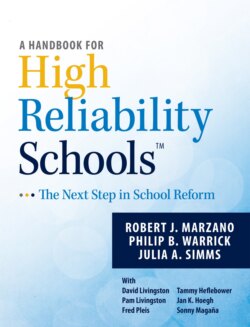Читать книгу A Handbook for High Reliability Schools - Robert J Marzano - Страница 8
На сайте Литреса книга снята с продажи.
A Hierarchy of School Factors
ОглавлениеFrom the 1950s to the 1980s, public education in the United States experienced a wave of pessimism regarding its potential to positively impact student achievement (Coleman et al., 1966; Jencks et al., 1972; National Commission on Excellence in Education, 1983; Rickover, 1959). Many condemned schools, saying they “bring little influence to bear on a child’s achievement that is independent of his background and general social context” (Coleman et al., 1966, p. 325). Although this criticism shed light on areas of weakness in the U.S. public education system, the conclusion that schools have no effect on student achievement is not valid for at least three reasons.
First, much of the research used to support the perspective that schools fail to impact students positively can be interpreted in alternative ways, some of which indicate that schools can cultivate high levels of student achievement. Second, there are many examples of highly effective schools that have successfully overcome the effects of students’ backgrounds. Third, and perhaps most importantly, school effectiveness research paints an optimistic picture of schools’ ability to impact student achievement. In fact, the aggregated research (including the following studies) indicates that there are clear, specific, and concrete actions that schools can take to dramatically increase their effectiveness.
Bosker, 1992
Bosker & Witziers, 1995, 1996
Brookover, Beady, Flood, Schweitzer, & Wisenbaker, 1979
Brookover et al., 1978
Bryk & Raudenbush, 1992
Bryk, Sebring, Allensworth,
Luppescu, & Easton, 2010
Creemers, 1994
Eberts & Stone, 1988
Edmonds, 1979a, 1979b, 1979c, 1981a, 1981b
Goldstein, 1997
Good & Brophy, 1986
Levine & Lezotte, 1990
Luyten, 1994
Madaus, Kellaghan, Rakow, & King, 1979
Mortimore, Sammons, Stoll, Lewis, & Ecob, 1988
Purkey & Smith, 1983
Raudenbush & Bryk, 1988
Raudenbush & Willms, 1995
Reynolds & Teddlie, 2000a, 2000b
Rowe & Hill, 1994
Rowe, Hill, & Holmes-Smith, 1995
Rutter, Maughan, Mortimore, Ouston, & Smith, 1979
Sammons, 1999
Sammons, Hillman, & Mortimore, 1995
Scheerens, 1992
Scheerens & Bosker, 1997
Stringfield & Teddlie, 1989
Townsend, 2007a, 2007b
van der Werf, 1997
Walberg, 1984
Wang, Haertel, & Walberg, 1993
Wright, Horn, & Sanders, 1997
To identify and describe specific factors that affect students’ achievement in school, researcher John Hattie (2009, 2012) synthesized close to sixty thousand studies and found that 150 factors correlated significantly with student achievement. Although a few of these factors are outside of a school’s control, the vast majority represent activities and initiatives that schools can implement and cultivate to increase their effectiveness. Hattie’s top fifty factors are listed in table I.1. Those that a school can control are shaded.
Table I.1: Top Fifty Factors Influencing Student Achievement
Source: Data from Hattie, 2009, 2012.
As indicated in table I.1 forty-six of the top fifty factors (92 percent) are within a school’s control.
For decades, schools have used educational research like Hattie’s to select individual factors to implement in their schools. For example, many schools have implemented response to intervention (RTI), the third factor in Hattie’s list. Other schools have implemented formative evaluation systems, the fifth factor in Hattie’s list. In some cases, schools have worked to improve their effectiveness relative to one, two, or several factors. While those efforts are laudable, they represent too narrow a focus. All of Hattie’s factors need to be arranged in a hierarchy that will allow schools to focus on sets of related factors, progressively addressing and achieving increasingly more sophisticated levels of effectiveness.
From a high reliability perspective, the factors identified in the research to date are best organized into the five hierarchical levels shown in table I.2.
| Table I.2: Levels of Operation for a High Reliability School | |
| Level 5 | Competency-Based Education |
| Level 4 | Standards-Referenced Reporting |
| Level 3 | Guaranteed and Viable Curriculum |
| Level 2 | Effective Teaching in Every Classroom |
| Level 1 | Safe and Collaborative Culture |
The hierarchical relationship of the levels depicted in table I.2 has some intuitive appeal. Level 1 can be considered foundational to all other levels. If students and faculty do not have a safe and collaborative culture in which to work, little if any substantive work can be accomplished. In essence, level 1 addresses the day-to-day operation of a school: What are the rules? How do we follow them? What will happen when the rules are not followed? How do we work together to make the school run optimally?
Level 2 addresses the most commonly cited characteristic of effective schools: high-quality instruction in every classroom. Stated differently, school leaders must make sure classroom teachers are using instructional strategies in a way that reaches all students and are taking appropriate steps to improve teacher competence when this goal is not being met.
High-quality instruction is a prerequisite for level 3, a guaranteed and viable curriculum. Guaranteed means that the same curriculum is taught by all teachers so that all students have an equal opportunity to learn it. Viable means that the amount of content in the curriculum is appropriate to the amount of time teachers have available to teach it (DuFour & Marzano, 2011; Marzano, 2003b). Levels 1 through 3 are common fare among current efforts to make schools more effective.
Level 4 moves into a more rarefied level of school reform, because it involves reporting individual students’ progress on specific standards. At any point in time, the leaders of a level 4 school can identify individual students’ strengths and weaknesses relative to specific topics in each subject area.
Level 5 schools exist in the most rarefied group of all—one in which students move to the next level of content as soon as they demonstrate competence at the previous level. Matriculation, then, is not based on the amount of time a student spends in a given course, but rather on his or her demonstrated mastery of content.
